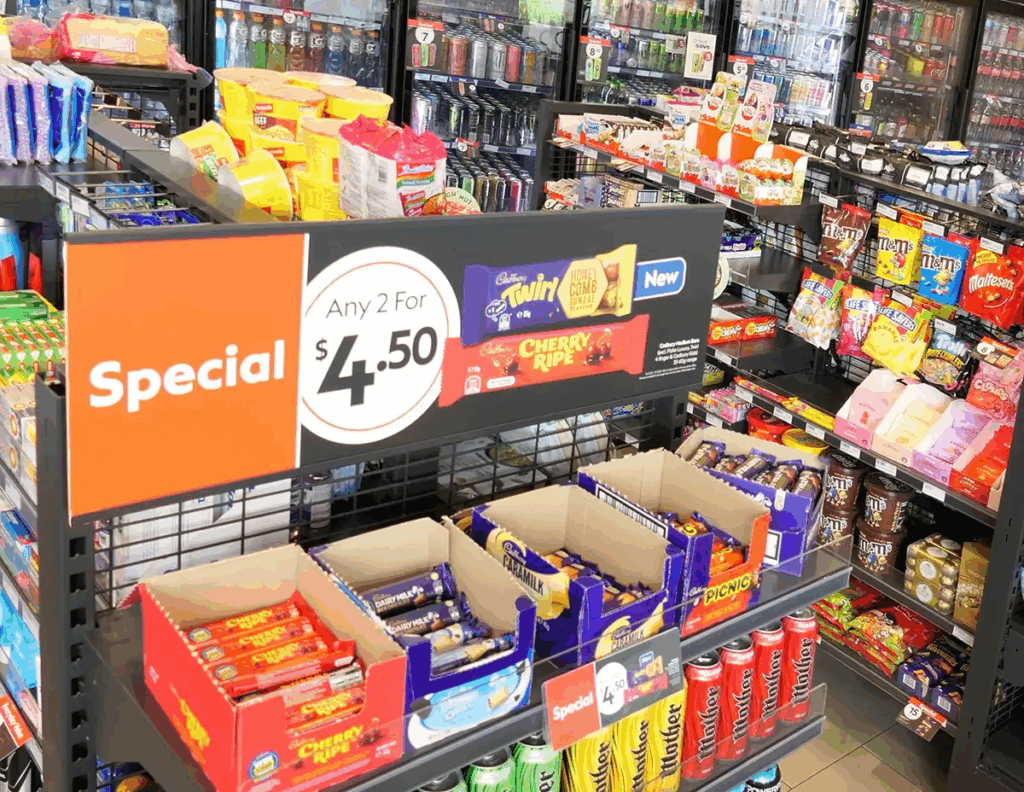A retail space should be easy to navigate and visually balanced. When customers can locate products quickly and read pricing or promotions without effort, they tend to spend more time browsing. Small adjustments, such as improving lighting or adding clear labels, have a measurable effect on how shoppers move and interact with displays.
At Mills Shelving, we see this in everyday retail settings. Stores that combine clear signage, organised shelving, and effective lighting often report smoother traffic flow and higher customer satisfaction. These three components—signage, label holders, and lighting—work together to guide attention, reduce confusion, and highlight product value.
Retailers investing in flexible shelving layouts gain the advantage of being able to adjust these elements as ranges expand or change. In that sense, upgrading shelving for better visibility and adaptability supports long-term growth and presentation consistency.
Good signage gives structure to the retail floor. It acts as silent communication, helping shoppers understand categories, locate products, and move naturally through aisles. A cluttered or unclear layout often discourages browsing and lowers confidence in product organisation.
Practical guidelines for effective signage include:
Mills Shelving provides gondola and wall shelving that accommodates multiple signage systems, including hanging rails, adhesive frames, and shelf-edge clips. This flexibility helps retailers refresh store messages without extensive refitting.
When we assist store owners, many find that improving signage placement leads to more even customer movement across sections. Linking categories with clear, brand-consistent visuals transforms the space from a collection of shelves into an organised experience.
Retailers who use shelves for shops designed for display and navigation efficiency can maintain that clarity across all departments, no matter the store size.
Clear labelling makes the buying process straightforward. Shoppers depend on accurate price tickets and product descriptions to make quick comparisons. Missing or unclear labels often lead to hesitation or missed sales opportunities.
At Mills Shelving, we often see stores use a mix of label holder types to suit different shelf styles:
Each holder type keeps information secure and visible, while also protecting tickets from dust and wear. Transparent covers make labels easy to clean and replace. Colour-coded strips can also help identify promotions, clearance items, or product categories at a glance.
Accurate labels also build customer confidence. When prices are consistent and clearly displayed, staff spend less time clarifying information, and checkout processes become faster.
Good lighting draws attention where it matters. It shapes how colours appear, defines textures, and makes signage easier to read. A well-lit shelf can turn a standard product into a focal point, while poor lighting can make even premium goods look dull.
Lighting for retail displays can be divided into three functions:
| Lighting Type | Purpose | Example Applications |
| Ambient | Sets the overall brightness and mood | Ceiling lights and general illumination |
| Task | Supports a specific action or area | Lights above checkout counters or fitting rooms |
| Accent | Highlights certain products or promotions | Under-shelf LEDs or track lights aimed at featured items |
Under-shelf LED strips are one of the simplest upgrades. They improve colour accuracy and make pricing or labels easier to read. Track lighting gives more flexibility since angles can be changed as displays move.
The Australian lighting market was valued at AUD 12.45 billion in 2024, with forecasts showing an 8.5 per cent annual growth through to 2034. This steady growth reflects how Australian retailers and businesses continue to invest in lighting not only for energy efficiency but also for presentation quality. For shopfitters and store owners, upgrading shelf and display lighting aligns with this national trend toward better illumination and product visibility.
Retailers using modular shelving can integrate these lighting systems with little effort. Shelves with adjustable brackets or perforated uprights make wiring and positioning straightforward. Many of our clients find that even small lighting changes produce visible results within days. Products appear cleaner, shelves feel more inviting, and customer flow becomes more balanced.

When signage, labels, and lighting are aligned, the retail space becomes self-guiding. Customers instinctively follow the cues created through light direction, label clarity, and sign placement.
A simple process many store managers follow:
At Mills Shelving, our team has seen the impact of these improvements first-hand. Retailers often begin with minor adjustments, such as introducing uniform label holders or replacing older fluorescent fittings with LED track lights. Within weeks, many report steadier shopper flow and longer dwell times around key displays. From our experience, stores that treat visibility as an ongoing process rather than a one-time upgrade achieve the best long-term results.
These three layers make the entire layout feel deliberate rather than cluttered. Shoppers no longer need to search; they simply move from one logical section to another.
Store owners who plan for periodic updates can make changes without major disruption. The same shelving systems can be refreshed to fit new layouts, signage, or product lines. For example, using future-proof shelving configurations that adapt with business growth keeps stores flexible even during seasonal promotions or rebrands.
Retail improvements work best when done systematically. A few simple steps can keep presentation standards high throughout the year.
Checklist for visibility upgrades:
Retailers often start small—adjusting light intensity or replacing worn ticket strips—before planning larger upgrades. Modular shelving makes these trials low-cost and reversible, giving flexibility to refine what works best for each store.
Clear signage, accurate labels, and balanced lighting combine to make the retail environment effortless to shop in. These quiet improvements influence perception and encourage repeat visits.
For many of our clients, the goal is to make the store layout speak for itself. With adaptable shelving, adjustable accessories, and clean lighting integration, that goal is realistic.Retailers seeking commercial shelving solutions for shops across Australia can create spaces that guide customers smoothly and present every product in its best light.